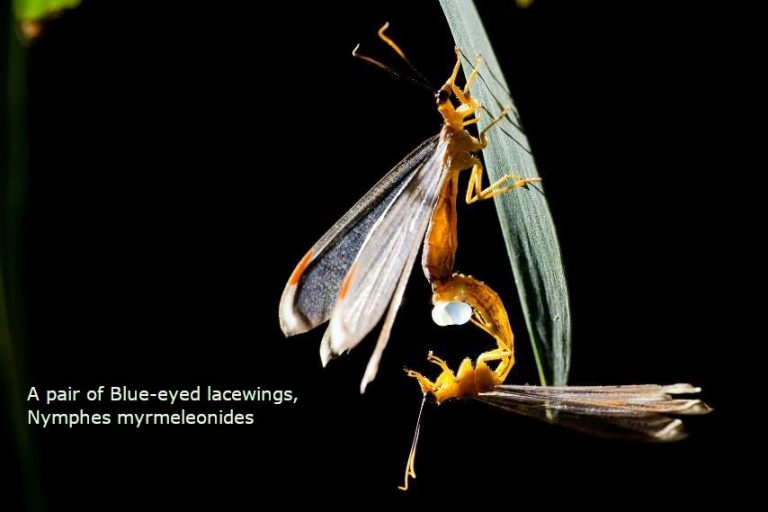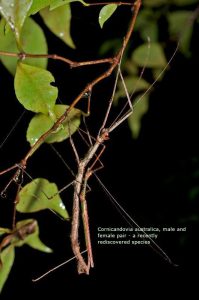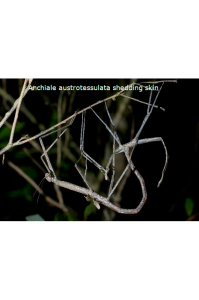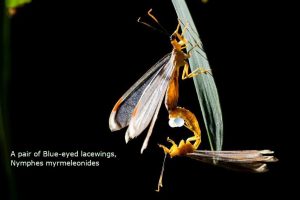
Excursion Report – Night phasmid-spotting excursion, 19 January 2024 Andy Williams Park, Cedar Creek
Leaders: Ross Coupland and Colleen Foelz
As evening closed in on a particularly hot, humid day in the Southeast, participants gathered at the picnic area at Andy Williams Park, Cedar Creek. Unstable weather the preceding days had put our planned walk into question, but thankfully the forecasted rain and storms remained further to the southwest and we had good weather, albeit extremely humid and around 27°C, long after dark. These conditions are ideal for insects of course. The summer months in Brisbane are the most favourable for finding the numerous species of stick insects or phasmids that occur here. Cedar Creek has particularly high diversity, likely due to its sheltered aspect, good variety of mixed, native vegetation and high relative humidity thanks to the nearby, permanent water source. At least 9 species of Phasmid are known to occur there, with likely several other species yet to be confirmed. Of particular interest are two poorly known species which seem to be restricted to the creek-side vegetation, feeding exclusively on Backhousia myrtifolia, Grey Myrtle.
We had 16 participants, so decided it best to split into two parties and to keep in contact via handheld UHF radios, should either group turn up anything of particular interest. A light sheet was also set up (thanks Maria) on the vegetation edge, and ran using one of the LepiLed systems. It was inspected at regular intervals for noteworthy invertebrates. Ross Coupland led one of the groups down to the creek on the north side of the park, while Colleen Foelz headed towards the southern side, along the road and around the edge of the park.
Ross’s group quickly encountered around 10 nymphs and sub-adults of Tesselated stick-insect, Anchiale austrotessulata, the most frequently encountered species in Brisbane, and also on our excursion. Most were feeding on Acacia fimbriata and Casuarina sp. trees. Once the group reached the creek, searching began in the favoured Backhousia myrtifolia bushes along the creek edge. The group quickly encountered the two target phasmid species, Cornicandovia australica and Candovia karasi. The latter being described only recently. C. australica presents an interesting case, whereby it was thought extinct on its recorded type locality of Lord Howe Island. We now believe it in fact has a patchy, mainland distribution and has simply been overlooked. The type locality was most likely recorded in error, due to miscommunication and sloppy labelling, not uncommon with early invertebrate trading. Both males and females were found, studied and photographed. The key, distinguishing features of each species clearly visible.
Also present on the Grey Myrtle bushes were several sub-adult Margin-winged stick-insects, Ctenomorpha marginipennis and yet more A. austrotessulata.
A few other notable insects were encountered, including praying mantids, Pseudomantis albofimbriata, numerous huntsman spiders, Blue-eye Lacewing, Nymphes myrmeleonides and a few frogs. Stony Creek, Striped Marsh and Red-eyed tree frogs were the most commonly seen or heard. A few Cane toads were present, but in low numbers, perhaps due to the somewhat rugged habitat and tendency for the creek to periodically flood.
The group on the other side of the park faired well, finding several large, adult specimens of A. austrotessulata and a mature male C. marginipennis. Although superficially similar to male A. austrotessulata, they can be distinguished by their longer, slender form and plain-brown wings, when compared to the chequered hind wings of A. austrotessulata.
Several insects of note arrived at the light sheet. These included a couple of ‘Christmas beetles’, Scarabaeidae and Dobsonflies (subfamily Corydalinae). Another stick insect, Didymuria violescens, Spur-legged/Purple-winged stick insect was found on a young Eucalyptus tree nearby. This individual was the sole representative of the Tropidoderinae subfamily. That is, phasmids which tend to resemble and feed on Eucalyptus predominantly. They are all typically long and green with pointed abdomens/wings, making them difficult to spot amongst gum leaves during the day, but become more conspicuous after dark, when they feed on the outer branches.
In all, an enjoyable, productive evening with most participants expressing appreciation for having the opportunity to explore after dark. Something which perhaps they would not normally do. After two hours of searching in the thick, humid air, everyone was glad to return to their air-conditioned cars for the return home.
Observations of phasmids from the location can be viewed here:
https://www.inaturalist.org/observations?nelat=-27.322105627850114&nelng=152.8261298478115&place_id=any&subview=map&swlat=-27.33259025448505&swlng=152.78529589776878&taxon_id=47198



